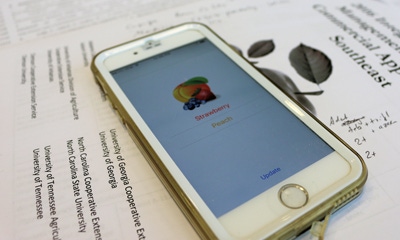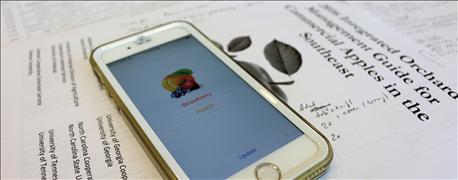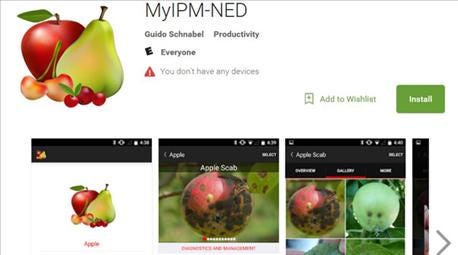October 10, 2016

No, smartphone apps can’t laser-zap diseases and bugs — yet. But three MyIPM apps can make in-the-field Integrated Pest Management of insects and diseases easier.
Initially designed for peach and strawberry growers in the Southeast, the MyIPM smartphone app series was created by Clemson University plant pathologists Guido Schnabel and Mengjun Hu. It’s been greatly expanded via collaboration with scientists from Cornell University, University of Massachusetts, Penn State University, North Carolina State University and University of Georgia.

FRUIT TECH TOOL: MyIPM apps bring next-gen IPM tech to smartphones and tablets. Scott Miller/Clemson University photo
• MyIPM-NED is the latest in the series, resulting from the collaborative effort. It focuses on managing fruit diseases specifically for Northeast apples, pears, cherries and cranberries. As with the other apps, it’s available free for Android and iOS (Apple) smartphone and tablet devices.
• MyIPM-SED has information on dozens of insects and diseases that attack peaches, blueberries and strawberries. The SED version covers southern-grown crops
• MyIPM-SEP, the third app, features advanced blueberry pest-control solutions and soon will feature the same for strawberries and peaches. The SEP version also targets southern-grown crops.
What’s inside the apps
Growers can reference high-resolution images to help diagnose disease or identify pests, says Schnabel. Audio files with university scientists outline treatment and prevention options.

APP DOWNLOAD WINDOW: This snip from the MyIPM-NED app window shows the opening page of the software.
Interactive tables outline effective chemical or organic control options, with research-based efficacy and toxicity profiles on dozens of commercial products. Information on the causal organisms, disease cycles, symptoms, biology and pesticide-resistance management is also covered. Yes, it’s all accessible via smartphone or tablet.
The MyIPM app is the only app of its kind, notes University of Georgia pathologist Phil Brannen, who collaborated with Schnabel on the project. “Some of the things we produce, which are really good resources, are more designed for the web and viewing on a computer screen,” he acknowledges.
“With this app and the photos and the identification tools that we have, it’s a readily available resource they can pull out of their pocket if they’re in the field,” he adds. “And, they’ll have treatment options at their fingertips immediately.”
Erika Saalau Rojas, an Extension plant pathologist at the University of Massachusetts Cranberry Station, says a mobile-diagnostic tool for growers hadn’t been available in her state before MyIPM. “What’s amazing about this app is that it’s very user-friendly. Having the ability to view high-resolution pictures, and being able to tell symptoms and signs, really streamlines the process of diagnostics.”
The MyIPM series is maintained at the Southern IPM Center at University of Georgia. Its back-end database allows regional experts to update information at any time. That makes it easy to update the apps with the newest information as science evolves.
It’s all in the apps and free for downloading from Apple iOS App Store or Google Play Store.
You May Also Like




